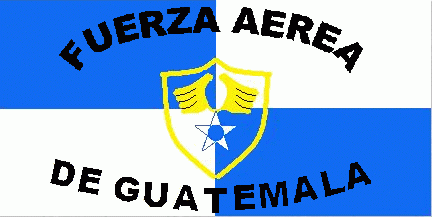
image by Klaus-Michael Schneider, 4 March 2009

Last modified: 2015-02-01 by zoltán horváth
Keywords: guatemala | fin flash | air force |
Links: FOTW homepage |
search |
disclaimer and copyright |
write us |
mirrors

image by Klaus-Michael Schneider, 4 March 2009
See also:
Guatemala Air Force flag:
The ratio is 1:2. It is aquarterly divided flag into blue and
white. In the centre of the flag is a shield quarterly divided in
the same way with a yellow bordure. The 5-point star from the air
force roundel with two yellow wings is superimposing the
quarters. There is a bowed inscription in black capitals “FUERZA
AEREA”(above shield) and “DE GUATEMALA”(below
shield).
Source: [ped79a]; p.249
Klaus-Michael Schneider, 4 March 2009

image by Željko Heimer, 22 October 2001
According to Album 2000 [pay00]
- Aircraft Marking - Blue roundel with white five-pointed star
throughout with blue disk inscribed. Civil flag is painted on the
fin, it is noted.
Željko Heimer, 22 October 2001

image by Željko Heimer, 22 October 2001
Military Aircraft Insignia of the World [cos98] gives such roundel for period
of 1923-1939 and 1947 onward, with some variations in the shades
of blue. During the interim period similar roundel was used, but
the star was sixpointed - with inner disk retaining its size,
i.e. not touching the inner points of the hexagram. Heraldy would
call that a mullet pierced.
Željko Heimer, 22 October 2001
Please note that any star (star polygon) in English heraldry
is "a mullet". The star on the first roundel would be
"a mullet pierced", that on the second roundel
(six-pointed one) would be "a mullet of six points
pierced". In French heraldry, however, the first one would
be an "molette a 5 raies" and the second a
"molette".
Santiago Dotor, 23 October 2001
Recently I was looking through a book that includes a section
on world airforces. The book is about WWII. Guatelemalan marking
is an azure circle with a Star of David inside which contains a
hole taking up most of the star's centre.
Rudi Roo, 17 April 2002
The first roundel (which is also the current rounde) can be
seen at <www.skytamer.com/guatemala/02.htm>,
The 1939-1947 roundel as in <www.skytamer.com/guatemala/03.htm>
appear also in Jan'es 1945 (with inner disc bigger then in the
image as reported above).
The Fin Flash (should be rudder stripes) is
based on [whe86]).
To day, many planes don't use this roundel. Fuerza Aérea
Guatemalteca (est. 15 Sept. 1921) used all kind of blue and white
(and soetimes also black) finish (sometimes even with rudder
stripes) but with no roundel. See <www.scramble.nl> and
<www.airliners.net/303064>.
Here is photos of planes using the roundel: in its glory: <www.hornstra.demon.nl/PC7>
, <www.hornstra.demon.nl/UH1>
and <www.hornstra.demon.nl/Pa31>.
On some planes only small fin flah is used again with no roundel:
<www.hornstra.demon.nl/PC7-2>
and <www.hornstra.demon.nl/IAI201>.
Dov Gutterman, 17 June 2004
I would like to point out, that the Air Force insignia that you document as
having being in use since 1923 (a six-pointed star) until 194xx, is factually,
incorrect.
Since the early days of the Cuerpo de Aeronautica Militar de Guatemala (later,
the Fuerza Aerea de Guatemala, then the Fuerza Aerea Guatemalteca) the
five-pointed star has been the norm.
The six pointed star was a one-time off mistake, committed by a U.S.
representative for the Ryan Aircraft company, upon the acquisition of Guatemala,
of a second batch of Ryan STM trainers in 1938. 12 were acquired, in two batches
of six. The markings were erroneously drawn by the gentleman on a piece of
paper, but were not approved by the Guatemalan Air Arm, and the airplanes were
delivered with the wrong insignia.
Please see attached image of letter.
Proof of this is, that no other aircraft on the fleet did ever carry the
six point star, and that as time went by, the Ryan STMs of the second
batch, eventually acquired the official five point star insignia. I have
plenty of photos to document this.
Tulio Soto, 26 January 2015

image by Dov Gutterman and Jorge Candeias, 9
October 1999
Fuerza Aérea Guatemalteca uses almost square civil flag as a
fin flash.
Dov Gutterman , 9 October 1999